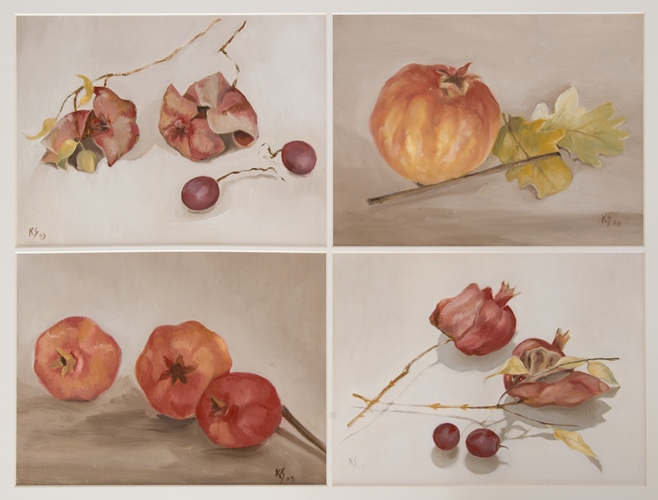1st Dec 2011 - 16th Dec 2011
Nature Quartets
Karen Shah
'Nature Quartets' are sets of four individual paintings designed and arranged for a single composition somewhat in analogy to quartet music where four instruments of the same or different family execute a sonata. The body of the work is executed in two distinct movements: the first explores the monumental potential of intricate natural structures as single descriptive units, while the second interprets their collective dissolution in time.
Autumn is the key: It is a season of maturity that brings grapes and pomegranates before nature slips into a winter of rest. Grapes are a symbol for abundance and rebirth; so too pomegranates are a symbol of abundance and fertility for they break open to release seeds that carry the promise of spring - while leaves, having run their living course, fall and decay.
The amniotic waters of the seas is what we perceive in the sound audible in the coil of the conch shell, perhaps a remnant memory of life that began in the seas; the mollusc that inhabits the shell is no less, one of the very first living organisms to have evolved in primordial waters.
Not surprisingly shells, leaves, grapes and pomegranates all found expression in early art forms and gradually found their way into myths and rituals world over.
When crafted into wind instruments large conch shells were said to sound a symbolic awakening from sleep and ignorance and to proclaim the victory of good. Their sound symbolised a consciousness of existence, and the hope of spreading knowledge in a call for communal participation.
In Italian Renaissance painting, it is a scallop shell that bears Venus - who was formed in the depths of the oceans - to the terrafirma; in the Baroque real shells were embedded in niches and artificial grottoes, as reminders of the natural and primitive world from where life began.
The simplest of shells have inspired the most elegant of Italian fountains. Shells and leaves embellish many a portal or cornice of important edifices with a grand simplicity that bonds the man-made with the natural world.
The mollusc, be it oyster, mussel or conch - whose shell is the support material in cameo crafting - also produces luxury items such as pearls and mother of pearl. In the past, products such as 'Imperial purple' dye and 'sea silk' were also obtained from these unassuming invertebrates.
As the shell belongs to the waters so the leaf belongs to the land. Both are recurrent in man's allegorical and spiritual observations; both are sources of food. Hindu scripture describes the banyan tree as the tree of knowledge, a wish-fulfilling tree that provides oxygen, shelter and medicinal oils; its aerial roots said to connect all living things in symbol of eternal life. Leaves became symbol of regeneration, for at the end of their cycle, they gracefully float back to earth to enrich the soil. Natural cycles know no waste.
The Plane tree leaf, or the Chinar leaf, known in Kashmir for its medicinal properties, is a recurrent motif in local embroidery and wood carving; the skeleton of the Peepal leaf is still widely used as a support for handicraft painting.
Entire trees are connected with spirituality and achievement: Buddha obtained enlightenment under the Bodhi tree, and its leaf, the Peepal leaf, is a symbol of peace. Oak trees were invariably found in the temple grounds of the ancient Greek and Roman gods, their leaves a symbol of faith and endurance; Hippocrates taught medicine at Kos under an Oriental Plane tree, known today as 'The tree of Hippocrates'.
The intention of these paintings is therefore to highlight these seemingly simple creations of nature now so taken for granted by Man, the youngest of all living things. Eventually man is as transient as the simplest leaf or shell for he is merely a part of a greater nature, and, there being no replacement for the natural, respect for Nature must be nurtured, for with it we nurture ourselves.
Karen Shah. Rome, September2011
